Introduction to water guns
Written by Ben
Last updated on 2017-06-03
This page serves as a general introduction to the topic of water guns and water wars. If you have any specific questions, it would be best to visit our FAQ or some other pages.
In addition to reading this guide, I would suggest reading the top 30 most asked questions here at Super Soaker Central to learn a little more about water guns. If you don't understand a particular word, check out the glossary.
Also check out our guide to the parts of a water gun, storing your soaker, choosing a weapon, measuring water gun statistics.
What are water guns?
Water guns are any device that shoots water. Typically the word Super Soaker is eponymous with water guns, but Super Soaker is just one brand of water gun. There are other brands, most notably Water Warriors and Storm, and there also are homemade water guns. You've probably seen water guns in TV commercials and toy stores.
Water guns are used mainly as recreational devices in water wars, though, some also use them for other purposes as varied as cheap pressure washing and applying pesticides in hard to reach places. There are many other reasons to enjoy water guns. Many people use them in games similar to water wars such as Assassins or river rafting. Some people enjoy building or modifying water guns for the design challenge involved. Some others enjoy collecting water guns. There are many reasons to enjoy water guns.
Water guns are typically seen as a children's toy, but many teenagers and adults enjoy water guns as well. Most of today's water gun market is targeted towards children, but many water guns, such as the CPS series Super Soakers made from 1996 until 2002, were targeted towards teenagers and adults. When the Super Soaker was first released, they found a surprise market in adults. Water guns made today are smaller in comparison to the older ones.
Why water guns? Why not paintball, airsoft, or Nerf?
Water gunning has several advantages over other sports like paintball, airsoft, and Nerf. First and foremost, the "ammunition" is nearly free and completely safe. Water is essentially free, unlike paintballs and Nerf darts. Water streams break up on impact, so they cause much less damage than solid projectiles. Injuries from water guns are unheard of. No face protection is necessary, but sunglasses are preferred.
Many people enjoy the style and size of the guns. Water guns are larger and heavier than paintball and Nerf guns. You need to be stronger to use and pump them. Running around with one can make you feel like Rambo. A lot of people like having a "super cannon," something other sports don't give you.
The style of the wars is particularly different from other war games. Unlike other games, a stream is shot, which has reduced range when compared against paintball, airsoft, and Nerf, but allows for adjustments in trajectory to be made during the shot. With a stream, assessing how much ammunition is left is more difficult than in other sports because water is used differently from paintballs and Nerf darts. Water wars require a more close and faster paced style of play that some enjoy more. Water wars are simply a different style of war game.
For those who want to point out that paintball hurts, being shot with a water stream isn't pleasant either, especially with hot or cold water. I would consider being shot with cold water to be particularly shocking. Anyway, while water streams might not leave bruises, most would consider that advantageous. Some people enjoy being shot with water—it helps them cool off on a hot summer day. Most people choose water guns because there isn't quite anything as good as a water fight on a warm summer day.
In water wars, like in paintball wars, detecting a shot is easy due to the change in color or tone. Unlike paintball however, little to no cleaning is required because the water will just dry up.
Water guns also cost much less money than paintball or airsoft guns. A top of the line modified or homemade water gun's price wouldn't even approach the price of decent paintball or airsoft equipment, and that's not factoring in safety equipment and ammunition.
There are obviously a variety of reasons to enjoy water gunning over other sports.
Water gun history
The basic story that every will tell you is that in 1982, a man named Lonnie Johnson was experimenting with a heat pump in his bathroom when his device accidentally shot a stream of water across the room. He thought it would make a neat water gun, and through his dedication in presenting it to toy manufacturers, it eventually was made into the Super Soaker we all know today. The first Super Soaker was originally called the Power Drencher, and that was released in 1989. That's only part of the story. For the entire story, be sure to read our water gun history section. There is a lot more to the history of water guns than the Super Soaker.
The "best guns"
Which guns are "best" is a topic of debate, as it depends on many factors. For a little more information on that subject, read our FAQ. Below I'll detail what most agree are candidates for the best gun. To read about all other water guns, check out our reviews.
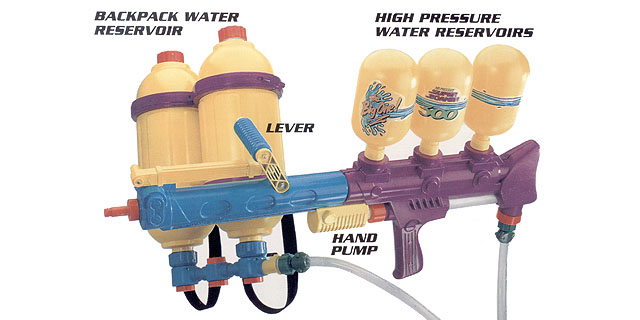
Of the early Super Soakers, the Super Soaker 300 is the only water gun able to stand up with later water guns, and it handles them very well. The gun boasted true 50 foot range and 5X water output. The X rating refers to how many ounces of water are shot from the nozzle every second (e.g. the SS 300 shoots 5 ounces per second). The gun had a backpack, a pump that pressurized the gun fast, and a unique style.
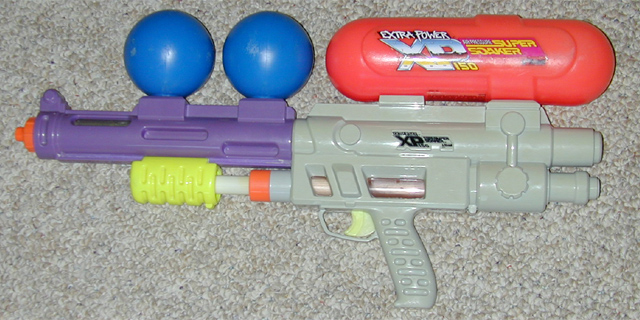
While the XP 150 has much less water output and range than other water guns, many still consider it among the best. The reason for that is because the XP 150 is lightweight, pumps fast, and shoots for a long time. If you pump the gun while shooting, you will actually put more water into the pressure chamber than what is going out the nozzle. The gun is great for its small size.
Most any CPS series water gun is a candidate for "best gun." The CPS series was a classic line of water guns by Super Soaker that were offered from 1996 until 2002. Normal air pressure water guns would experience a "drop off" in range and water output during the shot. The range and water output would decrease as the pressure decreased. CPS (constant pressure system) water guns use a rubber bladder to have constant pressure, and therefore constant range and water output. This system was revolutionary at the time.
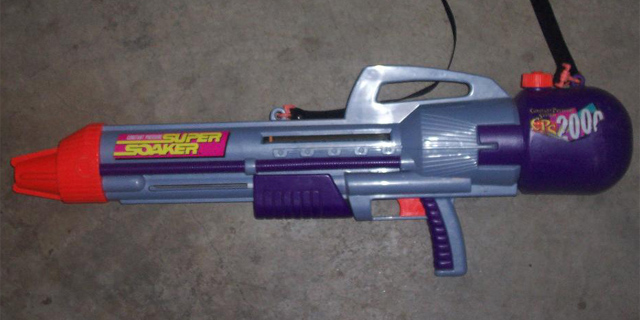
In 1996, the CPS 2000 was introduced, and even today, it is the most powerful manufactured water gun. The gun came in two versions. The 1996 version had a longer pressure chamber and is called the mk.1 version. The 1997 version had a shorter pressure chamber and is called the mk.2 version. Typically, it is agreed that the mk.1 version is the most powerful, but this is a topic of debate. However, if you are looking for the most powerful non-homemade and non-modified water gun, the CPS 2000 is what you are looking for.
In 1998, the "legendary '98s" were released, including the CPS 1000, CPS 1500, CPS 2500, and CPS 3000. These water guns are called the legendary '98s because all of them are great water guns in their own respect. All these guns had range of over 40 feet, which is very good among Super Soakers.
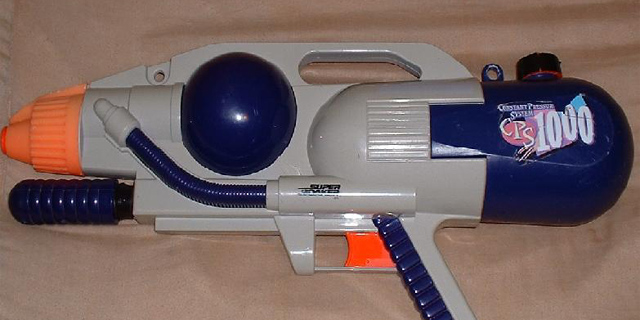
The CPS 1000 was a small CPS water gun with one 5X nozzle.
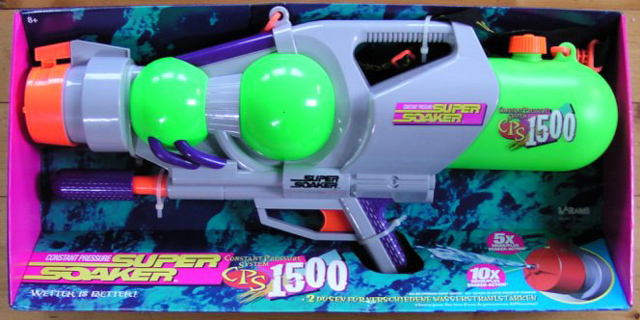
The CPS 1500 was a larger water gun with two nozzle settings, 5X and 10X. This water gun is commonly rated as the most versatile of all water guns due to the variety of nozzle settings and big water capacity in a relatively small package.
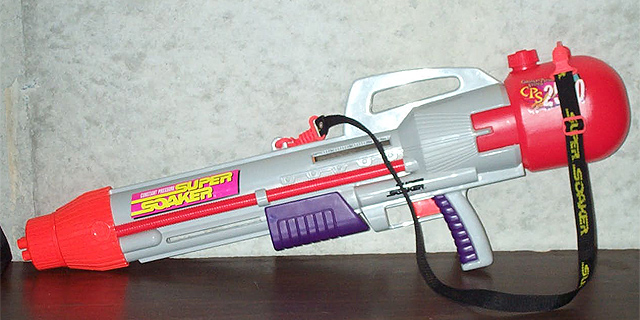
The CPS 2500 was very similar in looks to the CPS 2000. However, it had a smaller, less powerful pressure chamber, and a nozzle selector. The nozzle selector offered 5X, 10X, and 20X.
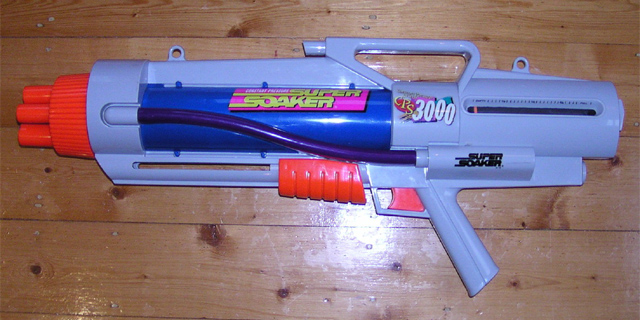
The CPS 3000 was the CPS water gun with a backpack. It had a 5X, 10X, 20X, and a special "Typhoon" blast nozzle.
Later CPS series' featured similar water guns. The CPS 1700 was essentially a renamed CPS 1500, and the CPS 3200 was a renamed CPS 3000 with a different backpack. The CPS 1200 and CPS 2100 are very similar to the CPS 1000 statistically and in size. The CPS 1-3-5 was received with mixed reviews from fans. It essentially was a CPS 1500 sized water gun with a nozzle that can shoot 5 1X streams. The CPS 4100 was somewhat similar to the CPS 2500, except it was less powerful and had different styling.
The Monster series was released in 2000 with very large water guns. While the range may be lower than that of CPS series water guns, the guns are considered some of the best due to their large size, wide variety of nozzle settings, and good water capacity.

The Monster XL, pictured above, is typically the most desired of the Monster series due to it's very large size, two CPS chambers, and two nozzles. The Monster XL is the largest manufactured water gun ever.
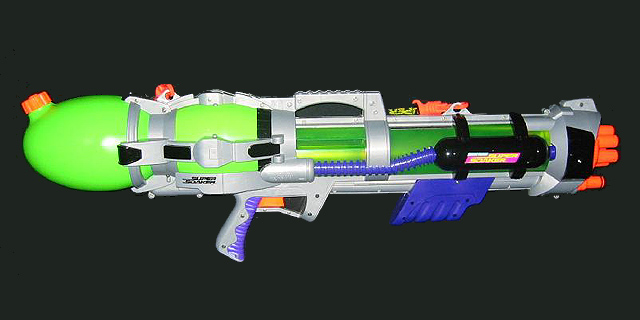
The Monster X is also highly desired as the smaller cousin of the Monster XL.
Water wars
Water guns themselves are used mainly for water wars. Here at Super Soaker Central we have several sections dedicated to water wars. You can watch water war videos in our video section. You can read water war strategies in our tactics section. You can read stories about water wars in our war stories section.
Outside of this website, water wars themselves are developing into a more organized sport. 2006 saw the formation of the Water War League. New events will be organized under the WWL name, so be sure to check that forum often.
How do water guns work?
A common question is how water guns work. The answer to that question depends on the type of water gun. We have an article that explains the basics of how several types of water guns work with some links to other explanations as well. We also have a page about the parts of most water guns to give you a good idea of what we are talking about.
Modifications
One popular topic in water guns is modifying water guns. The customization of water guns is a part of this hobby that attracts many people. Popular modifications include the K-mod, which can be done to several CPS water guns to increase power. The Colossus. modification can be done to all other CPS water guns to increase power. Nozzle sizes can be changed through nozzle drilling. Backpack modificationsadd a backpack water reservoir to your water gun. Modifications can customize existing water guns to be more like what you want.
Homemade water guns
In the last few years, homemade water guns have become a lot more popular. Basically, homemade water guns are water gun you build yourself. There are no limits at all. Power can be as high or as low as you want it. Size and shape are completely up to the builder. Water capacity, and where the water is stored is up to the builder. Everything is up to the builder. Exactly what the builder is looking for is possible. To support water gun builders we have the biggest homemade water gun section online here at Super Soaker Central. Check it out if you are interested in building your own water gun.
What's the deal with Hasbro? Why can't water guns get better?
Hasbro owns the Super Soaker line. Recent Super Soakers and other water guns have been a far cry from the peak of 1996 until 2002. There are several reasons that are not completely clear for this.
First off, Hasbro itself buying Larami did not translate into a change in water gun design. Hasbro has owned Larami since 1995, but they did not completely absorb Larami until 2003 when the name Larami ceased to exist. Those who place all the blame on Hasbro don't realize that all of the CPS series was produced under their watch. However, the complete absorption of Larami seems to have coincided with a change in water gun design.
What is clear is that larger water guns do not sell very well. Combine that with the fact that larger water guns take up more shelf space, larger water guns translate into less profits for retailers. Unlike what you may believe, retailers have a lot of leverage in what can sell. Back in 2004, we were told that the "price limit" by consumers was set at $20 and that water guns had to be smaller than those in the peak. Anything higher than $20 simply wouldn't sell.
What seemed like complete flops to hobbyists like the EES line, the Oozinator, and AquaSquirtz, were likely attempts to sell to the market. Children are today's water gun market, sadly.
However, recent times have made those justifications seem less likely. In 2007, a water gun called the HydroBlitz was released. The HydroBlitz is similar to the CPS 1500 in size, but definitely not performance. The HydroBlitz retailed for $39.99, which is twice as high as the supposed price limit. Hasbro also revealed that their 2008 Nerf line will be more targeted towards adults. We do not know what Hasbro's plans for the future are, but they appear to be trying to break into the market with larger, albeit underpowered, water guns.
Are the days of big water guns behind us? Perhaps, but the situation is far from hopeless. Older water guns can be bought used from yard sales, thrift stores, and eBay. Homemade water guns are increasingly popular choices. And I wouldn't count the market out either. In 2004, the CEO of Buzz Bee Toys who make the Water Warriors line of water guns asked hobbyist if they would be interested in a high powered water gun that would sell at sporting good stores to an older audience. While this has yet to materialize, it's not outside the realm of possibility.
Biggest websites
There are a lot of other great water gun websites out there. I suggest that you visit our links page to see a listing of pages that we recommend checking out.